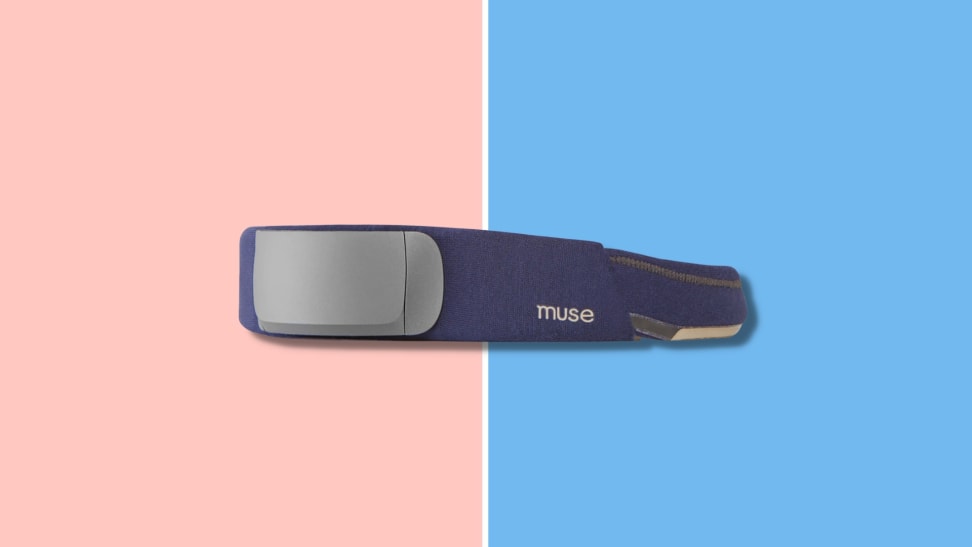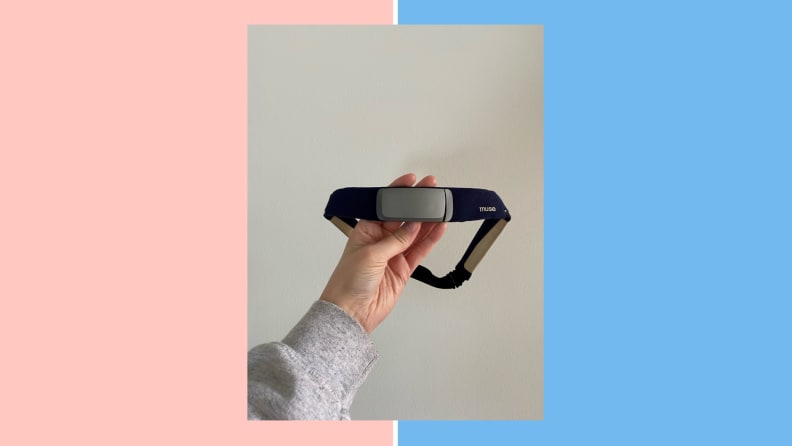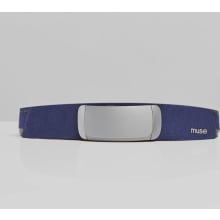Muse S (Gen 2) Review
Pricey Muse S headband measures brainwaves to track your sleeping habits
 Credit:
Reviewed / Muse
Credit:
Reviewed / Muse
Products are chosen independently by our editors. Purchases made through our links may earn us a commission.
-

Muse S (Gen 2)
Pros
-
Good guided meditations
-
Interesting sleep-tracking features
Cons
-
High cost for its benefits
-
Tough pairing process
-
Similar meditations found elsewhere
-
No multi-language support
-
I had incredibly high hopes for the Muse S brain-sensing headband when I was asked to try the product as a meditation tool. I’m not someone who is readily meditative, so it takes a lot for me to drown the world out. Muse is a biofeedback headband that collects data from your brainwaves while you meditate or sleep, which can help you track how deeply you’re actually relaxing. It’s the first of its kind to allow this type of scientific measurement at home, and with that cutting-edge technology comes a hefty price tag.
The Muse S headband sits at a steep $399 retail cost, which feels like a lot, especially when you open the box and see what looks like a high school gym class heart rate monitor. However, that didn’t stop me from giving the Muse S a fair shot at making me a relaxed lady.
It’s important to note that meditation is obviously only as productive as you allow it to be. But, despite my best efforts, Muse just didn’t help me get anywhere in terms of fostering my personal sense of mindfulness.
About the Muse S brain-sensing headband
Even though the Muse S looks unabashedly simple in its presentation, it’s a highly technical product. There are plenty of health monitor devices on the market, but this one differs from those others in its ability to function as an in-home electroencephalogram (EEG).
When connected properly, the Muse S can read the wearer’s brainwaves to measure one’s heart rate, brain activity, and mindfulness to offer real-time feedback straight from the source. It catalogs and displays these results in a series of graphs and charts, which can then be compared to one another as you progress through your mindfulness and meditation journey.
The cornerstone of the Muse S’s ability to provide this data, though, is its wide assortment of meditations focused on aspects like mind, body, heart, and breathing. One section, called digital sleeping pills, is able to smartly fade away as you fall asleep and then increase in volume as you wake up. In short, if you want to be fully sure you're achieving perfect rest and mindfulness, the Muse S is one of the most technically sophisticated ways to do it.
What I like about the Muse S brain-sensing headband
Guided meditations

The inside of the Muse S headband is sophisticated enough to measure brainwaves. It functions as an at-home EEG.
Muse boasts a long list of guided meditation sessions and relaxing soundscapes that may help calm your mind and nudge you deeper into a peaceful meditation. There’s no shortage of selections depending on what you’re looking for—be it a 5-minute breather or a 15-day, self-love journey. The Muse headband excels in its options, but don’t be completely fooled.
Other apps, like Headspace and Calm, provide a similar service. The difference is that Muse comes with an expensive headband that displays and records numerical data to back up your activity. Determining if that data is truly accurate or worth the price of admission is up to you and you alone.
Sleep mode
Another area where Muse S impresses is with its sleep data. There are sleep tracker apps like Sleep Cycle that allow users to monitor the depth of their sleeping state. However, Muse offers this benefit through fully functional EEG sensors and hardcore data. It records real brainwave activity to differentiate between restful versus restless sleep. The thoroughness with which this feat is accomplished just isn’t happening elsewhere.
Muse supports multiple users
Maybe the best part of Muse is that it can be used with multiple people, so one household only needs to buy a single headband. That factor reduces the investment cost significantly if you’re looking to make a family project out of meditation, rather than investing in a Muse for each member of the family.
What I don’t like about the Muse S brain-sensing headband
High cost for little benefit
For what Muse offers, it’s hard to justify its nearly $400 price tag. It’s exciting that Muse features in-home biofeedback—there’s no denying that. But the overall experience makes me think the brand still has some ways to go in terms of proving what the incentive for having that added data actually is.
This is a great product if you’re curious about what’s happening on the inside of your body— which you’re often unable to see. If you simply don’t care how your body responds to mindfulness, or what your sleep data looks like, this product probably isn’t worth its cost.
This is a device for data-minded people, not the everyday user who isn’t thinking much about their patterns and physical deficits. And that’s not a bad thing: Muse certainly knows its target audience. But if you’re someone who’s just looking to meditate, there are much more affordable options with similar libraries of relaxation materials.
Requires perfection for a connection

Make sure you set aside plenty of time to ensure the Muse S headband is properly paired to work with its companion app.
Setting up the Muse app and connecting the headband to Bluetooth was simple, but actually participating in meditation was a different story. It took literal hours to establish a good connection to my Muse headset.
In the end, it took adjusting the headband to uncomfortable tightness and removing all makeup and moisturizer from my face to get a signal that held for the duration of my meditation. By the time I actually started meditating, I was frustrated with the product and unable to fully relax. This issue is worsened by the fact that the headset needs to be recalibrated for every single meditation you do. If you struggle to get Muse S working, repeated fit issues are likely to be a huge annoyance.
No multi-language support
Another consideration with the Muse app is that it’s currently only available in English, meaning non-English speakers won’t be able to navigate the experience with ease. As an accessibility product, Muse’s lack of multi-language support is a huge negative given how many potential buyers the omission rules out.
Lacking a unique point
The main consensus I keep returning to is that S Muse fulfills the purpose of providing biofeedback but doesn’t offer much more than that. While this is an interesting tool to bring into a home (typically biofeedback is used in very specific, guided therapy sessions), it feels like there should be more in the overall package given its price.
Should you buy the Muse S brain-sensing headband?
Not unless you really need data to back up your plan.

If you're a true data nerd who needs to know everything about how you sleep, the Muse S may be for you.
If meditation is the goal, there’s little real reason to have an EEG headband like the Muse S to assist you unless you really want to be sure you’re achieving maximum relaxation. And if data is the goal, there seem to be more reasonable, professional options to help you interpret data and come up with a more concrete self-improvement plan. Not to mention, it may actually be cheaper to pursue biofeedback therapy than to buy a headband, of course, depending on your insurance status.
Muse S hands users a whole bunch of data, and, unless you know what to do with it, it’s not particularly helpful. It almost feels like an astrology reading, or a first date: New information is really exciting the first time you lay your eyes on it, but it loses its shine once it’s no longer new. The data Muse provides, at best, may be helpful in gauging unhelpful routines and distractions. Whether or not it’s worth purchasing as a long-term investment is debatable.

The Muse S headband helps with meditation and gathers your sleep data for maximum analysis.



